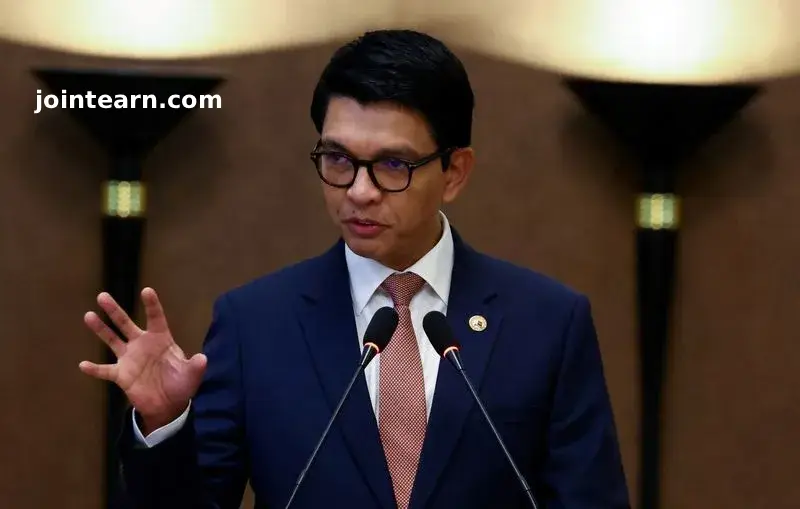
In a dramatic escalation of Madagascar’s political crisis, President Andry Rajoelina announced the dissolution of the National Assembly on Tuesday, deepening the standoff between his administration, the military, and a surging youth protest movement that has swept across the country.
The decree, published on the presidency’s official Facebook page, stated that the president had “consulted” with the leaders of both legislative chambers before issuing the order — though its constitutional validity was immediately challenged by lawmakers and opposition figures.
Rajoelina’s move came just days after he reportedly fled Madagascar amid widespread demonstrations and a wave of military defections, further isolating his administration.
Rajoelina Defiant in Address from Hiding
Speaking in a defiant televised address from an undisclosed location on Monday night, Rajoelina — 51 years old and a former media entrepreneur — vowed not to resign despite growing pressure from protesters and the armed forces.
“I have been forced to move to a safe place due to threats against my life,” he said, insisting that his decision to dissolve parliament was necessary to “restore order” and “give power back to the people.”
In a separate post on X (formerly Twitter), Rajoelina added:
“The people must be heard once again. It’s time for the youth.”
His message was seen as an attempt to appeal directly to Generation Z activists, whose protests against rolling blackouts, water shortages, and government corruption have morphed into a nationwide call for regime change.
However, opposition leaders swiftly denounced the decree as illegitimate and unconstitutional.
“This decree is not legally valid,” said Siteny Randrianasoloniaiko, vice president of the National Assembly. “The president of the Assembly was not consulted. Rajoelina’s actions only deepen the crisis.”
Parliamentary Revolt and Impeachment Push
For weeks, opposition lawmakers have been attempting to gather enough signatures to launch impeachment proceedings against Rajoelina. Their efforts have gained traction amid mounting defections within the military, a crucial pillar of power in Madagascar’s fragile democracy.
While Rajoelina’s ruling coalition technically retains a majority in the National Assembly, his grip on power has weakened significantly since early October, when security forces began joining the protests.
Nationwide Gen Z Protests Transform Into a Uprising
The crisis erupted on September 25, when thousands of young demonstrators took to the streets to protest frequent power outages and water shortages in the capital, Antananarivo.
What began as a call for better infrastructure quickly escalated into a mass anti-government movement, uniting students, civil servants, and unions under a single banner of reform. Protesters have cited corruption, inequality, and poor governance as root causes of their anger.
On Tuesday, Antananarivo’s iconic 13 May Square — lined with palm trees and remnants of French colonial architecture — became the epicenter of the demonstrations. Thousands of young people danced, sang, and waved banners, including the now-iconic skull-and-crossbones flag inspired by the anime series “One Piece,” a symbol of rebellion embraced by Gen Z movements worldwide.
Chants of “Rajoelina must go!” echoed through the capital as protesters waved Malagasy flags and accused the president of being a “French puppet” — a reference to his dual French-Malagasy citizenship and his perceived closeness to Paris.
France and International Community React
French President Emmanuel Macron commented on the unfolding crisis, emphasizing that constitutional order must be respected while warning against the military’s exploitation of youth unrest.
“France understands the legitimate grievances of Madagascar’s youth,” Macron said in a statement, “but their voices should not be manipulated by factions seeking power through unconstitutional means.”
The international community, including the African Union and United Nations, is expected to issue formal responses in the coming days amid concerns about another military takeover in the region.
Military Defections Leave Rajoelina Isolated
Rajoelina’s isolation deepened after losing the support of the CAPSAT military unit — an elite corps that had once been instrumental in his rise to power during the 2009 coup.
Over the weekend, CAPSAT commanders joined the protesters, declaring they would refuse to open fire on civilians. They later appointed a new army chief and assumed control of the country’s armed forces, a move Rajoelina described as an “attempted seizure of power.”
In response, the paramilitary gendarmerie and national police also broke ranks, leaving the president with little institutional backing.
Madagascar’s Deepening Economic and Social Crisis
Madagascar, home to about 30 million people, has one of the youngest populations in the world — with an average age under 20 years old. Despite its vast natural resources and status as the world’s largest vanilla producer, the country struggles with chronic poverty and underdevelopment.
According to the World Bank, 75% of Malagasy citizens live below the poverty line, and the nation’s GDP per capita has fallen by 45% since independence from France in 1960.
The current uprising reflects not just political anger, but decades of frustration with a system that has failed to deliver progress. The protesters’ message is clear: they want transparency, jobs, and a government that works for the people — not the elite.
A Nation on the Brink
As Madagascar teeters on the edge of another military-led transition, the coming days may determine whether the island nation can return to constitutional order or descend into another cycle of coups and instability.
With Gen Z protesters continuing to flood the streets and the military asserting dominance, President Rajoelina’s future appears uncertain. For many Malagasy citizens, the question is no longer whether the old guard will fall — but what kind of leadership will rise to replace it.
Leave a Reply